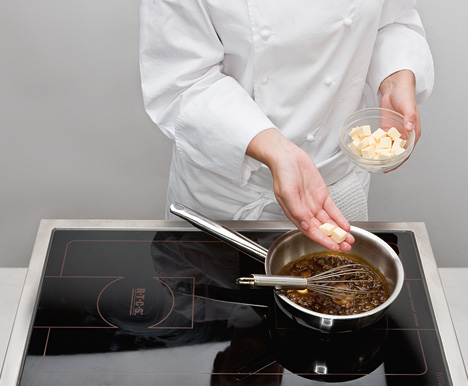
Полная версия
Sauces in French Cuisine
Amidon de Ble (Wheat Starch [rice, corn, potato or arrowroot starch, and others])
Depending on the type of starch used, the thickening ratio varies strongly. All starches except rice flour must be dissolved in a cold liquid before use. Add subsequently to hot, but not boiling liquid, stirring it constantly. Starches begin to thicken best from 80 °Celsius and lose some (approx. 10 %) of their thickening power above 90 °Celsius. This is why they are added shortly before serving. Starches provide thickened sauces with a silky shine and do not have to boil through. They are particularly suited for the short-term (re-)thickening of sauces because they do not have a specific aftertaste, other than flour.
LIANTS POUR SAUCE, PRODUITS INDUSTRIELLEMENT (Commercial Sauce Thickeners)
Modern, commercially produced sauce thickeners are based upon starch. Through special processing procedures, e.g. freeze-drying or roller drying, immediate solubility is reached (instant products). There is no “caking” when stirring it into hot or cold liquids. The thickening power and temperature of sauce thickener is the same as for starch.
CREME – Double, SAUCES, AIGRE (Cream – Double, Whipping, Sour)
Sauces thickened with cream only will have a rather liquid consistency. They give the impression of relatively light sauces. The truth, however, is that such sauces have a higher energy content than sauces thickened with flour or starches. On the one hand, whole cream or half-and-half are added, and then reduced to reach the desired texture. On the other hand, adding cream is intended to improve the sauce. One can reach a stronger thickening result by folding in the cream or sour cream to the hot, but not boiling sauce just before serving. Sour cream goes well in some sauces (Sauces aux Champignons, Sauces Venaison), but it is by far not the perfect match for all sauces. Before adding it to the sauce, add sour cream to a small amount of sauce and check taste. Here the same principle applies in respect of salt and spices: what has been added is in the sauce – you can always add something to it, but you can never remove anything from it!
Which type of cream to use depends mostly on one’s individual taste. Single cream: whipping cream, between 30 to 36 % milkfat. Double cream / Crème double at least 40 % / milkfat, in Switzerland 45 % milkfat. Half cream 25 % milkfat. Sour cream: light sour cream with at least 10 % milkfat, smetana (sour cream) with 20 to 29 % and crème fraîche with at least 30 % milkfat.
Jaune d’œuf (Egg Yolk)
Egg yolk is often used to thicken desserts, in case of savoury sauces it is usually used in combination with cream or to bind butter and oil sauces. The use of egg yolk as a thickener is a delicate matter because it coagulates from 83 °Celsius and starts to clot, yet its maximum thickening power is only reached just underneath that threshold, i.e. at temperatures between 80° to 82 °Celsius. Thickening sauces with egg yolk therefore requires experience and an exact working method (e.g. when whisking Butter Sauces).
As an alternative, one may use the following, slightly outdated egg yolk method: strain a boiled egg yolk through a fine sieve, put into mortar or food processor and crush with a little bit of cream. Stir this mixture into hot liquid, boil through, stirring the sauce vigorously, and strain through cheesecloth. Coagulated or hard-boiled egg yolk does not lose its thickening power.
Liaison (Thickening with Egg Yolk and Cream)
The thickening ratio for 1 litre (1 3/4 pt or 4 1/2 U.S. cups) of liquid / sauce: 1 to 2 egg yolks and 100 to 200 ml (3 1/2 fl oz or 1/2 U.S. cups to 7 fl oz or 7/8 U.S. cups) of cream, always in a 1:1 ratio. Beat egg yolk and cream in a bowl with a whisk, slowly add approximately 20 ml (7 fl oz or 7/8 U.S. cups) of the hot sauce, whisking vigorously. Add mixture subsequently to hot, but not to boiling liquid, stirring it constantly. Reduce by vigorously stirring and boiling through. The sauce will then be mixed and subsequently strained through a cheesecloth.
Liaison / Thickening with Egg Yolk and Cream
1. Separate egg yolk from egg white.
2. Add cream to egg yolk.
3. Mix egg yolk and cream. Subsequently add some of the sauce to be thickened before stirring Liaison into sauce.

1. Separate egg yolk from egg white.

2. Add cream to egg yolk.

3. Mix egg yolk and cream. Subsequently add some of the sauce to be thickened before stirring Liaison into sauce.
BEURRE (Butter)
General rule: Cut butter in required quantity into slices or cubes the size of a thumbnail and ca. 2 mm thick. Fold into the hot sauce (approx. 70 °Celsius), stirring vigorously with a whisk or a blender. This vigorous stirring or whisking method results in a certain degree of homogenization. Do not reheat sauce, this would destroy homogenization and the thickening effect: the butter (milkfat) would separate from the sauce and float on top.
Tip: Add pieces of butter cooled in ice water to hot sauce (ca. 80 °Celsius), carefully, yet constantly, whisking and tossing it until the desired thickness has been reached. Curiously, better thickening results are achieved by gentle stirring and tossing rather than by vigorous whisking.
Foie gras / fattened duck or goose liver: According to taste, butter may be replaced by foie gras de canard (duck) or foie gras d’oie (goose), however, it has to be puréed first and strained through a cheesecloth. See Sauce Rouennaise.
Monter – Mount with Butter
1. Remove prepared sauce from heat, add butter.
2. In the pan, slowly whisk and toss butter into sauce in a circular motion until reaching desired consistency.

1. Remove prepared sauce from heat, add butter.

2. In the pan, slowly whisk and toss butter into sauce in a circular motion until reaching desired consistency.
MONTER – Whisk in Butter
1. Remove prepared and hot sauce from heat, add butter.
2. Add butter to sauce using a whisk, stirring it vigorously, until reaching desired consistency.

1. Remove prepared and hot sauce from heat, add butter.

2. Add butter to sauce using a whisk, stirring it vigorously, until reaching desired consistency.
Sang (Blood)
In the past, stews from roe deer, boar or deer used to be thickened with fresh pig’s blood (blood of other animals is also possible, for instance hare’s blood, if available). This thickening method is rather rare today. The thickening ratio for 1 litre (1 3/4 pt or 4 1/2 U.S. cups) of liquid / sauce: 100 ml (3 1/2 fl oz or 1/2 U.S. cups) of pig’s blood. Freshly slaughtered, stirred blood is the prerequisite. Stir blood into hot, but not boiling sauce, and strain through a cheesecloth. The blood may be mixed with cream in a 1:1 ratio before adding it. Blood reacts similarly to egg yolk when it comes to temperature: the optimum thickening power starts around 80 °Celsius and coagulation begins at 85 °Celsius. Products thickened or rounded off with blood are more delicate, and spoil more quickly, than other products. Unfortunately, fresh pig’s blood as a thickening agent has a bad reputation today.This is totally unjustified because well dosed and subtly used, it provides Sauce Venaison with a marked, velvety consistency and a subtle, but quite unmistakable, flavour and typical colour.
Конец ознакомительного фрагмента.
Текст предоставлен ООО «ЛитРес».
Прочитайте эту книгу целиком, купив полную легальную версию на ЛитРес.
Безопасно оплатить книгу можно банковской картой Visa, MasterCard, Maestro, со счета мобильного телефона, с платежного терминала, в салоне МТС или Связной, через PayPal, WebMoney, Яндекс.Деньги, QIWI Кошелек, бонусными картами или другим удобным Вам способом.

